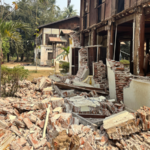A powerful earthquake struck central Myanmar on March 28, leaving historic landmarks battered and raising concerns about long-term impacts on cultural preservation. The tremor caused partial collapses at the 19th-century Mandalay Palace ruins – a UNESCO World Heritage site that serves as a living chronicle of Myanmar's royal past.
The iconic U Bein Bridge, a 1.2-kilometer teakwood structure spanning Taungthaman Lake, suffered critical structural damage. Authorities have closed the 160-year-old landmark indefinitely, disrupting both tourism and daily life for residents who rely on the bridge for transportation.
"This isn't just about tourism dollars – these sites are part of our national identity," said a conservation expert working at the palace site, who declined to be named due to protocol constraints. Emergency teams are currently stabilizing damaged structures while engineers assess restoration feasibility.
The quake's timing compounds challenges for Myanmar's cultural sector, which preserves architectural treasures from the Pagan Kingdom's golden age through British colonial-era monuments. Nearly 18% of the country's workforce depends on tourism-related industries, according to pre-pandemic economic data.
As international heritage organizations monitor the situation, local authorities continue search-and-rescue operations in affected regions. The full cultural and economic ramifications remain unclear as damage assessments progress.
Reference(s):
cgtn.com








